Red blood cell
| Red blood cells | |
|---|---|
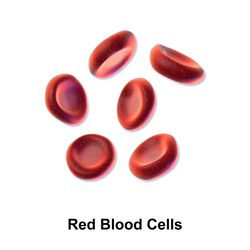 3D rendering of human red blood cells (c. 6–8 μmin diameter) | |
| Details | |
| Function | Oxygentransport |
| Identifiers | |
| Acronym(s) | RBC |
| MeSH | D004912 |
| TH | H2.00.04.1.01001 |
| FMA | 62845 |
| Anatomical terms of microanatomy | |
Red blood cells(RBCs), referred to aserythrocytes(fromAncient Greekerythros'red' andkytos'hollow vessel', with -cytetranslated as 'cell' in modern usage) in academia and medical publishing, also known asred cells,[1]erythroid cells,and rarelyhaematids,are the most common type ofblood celland thevertebrate's principal means of deliveringoxygen(O2) to the bodytissues—via blood flow through thecirculatory system.[2]Erythrocytes take up oxygen in thelungs,or in fish thegills,and release it into tissues while squeezing through the body'scapillaries.
Thecytoplasmof a red blood cell is rich inhemoglobin,aniron-containingbiomoleculethat can bind oxygen and is responsible for the red color of the cells and the blood. Each human red blood cell contains approximately 270 million hemoglobin molecules.[3]Thecell membraneis composed ofproteinsandlipids,and this structure provides properties essential for physiologicalcellfunction such asdeformabilityandstabilityof the blood cell while traversing the circulatory system and specifically thecapillarynetwork.
In humans, mature red blood cells are flexiblebiconcave disks.They lack acell nucleus(which is expelled duringdevelopment) andorganelles,to accommodate maximum space for hemoglobin; they can be viewed as sacks of hemoglobin, with aplasma membraneas the sack. Approximately 2.4 million new erythrocytes are produced per second in human adults.[4]The cells develop in thebone marrowand circulate for about 100–120 days in the body before their components are recycled bymacrophages.Each circulation takes about 60 seconds (one minute).[5]Approximately 84% of the cells in the human body are the 20–30 trillion red blood cells.[6][7][8][9]Nearly half of the blood's volume (40% to 45%) is red blood cells.
Packed red blood cellsare red blood cells that have been donated, processed, and stored in ablood bankforblood transfusion.
Structure
Vertebrates
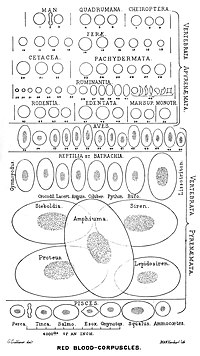
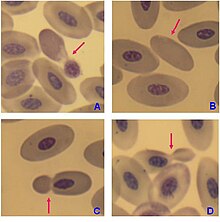
The vast majority of vertebrates, includingmammalsand humans, have red blood cells. Red blood cells are cells present in blood to transport oxygen. The only known vertebrates without red blood cells are the crocodile icefish (familyChannichthyidae); they live in very oxygen-rich cold water and transport oxygen freely dissolved in their blood.[11]While they no longer use hemoglobin, remnants of hemoglobin genes can be found in theirgenome.[12]
Vertebrate red blood cells consist mainly ofhemoglobin,a complexmetalloproteincontaininghemegroups whose iron atoms temporarily bind to oxygen molecules (O2) in the lungs or gills and release them throughout the body. Oxygen can easilydiffusethrough the red blood cell'scell membrane.Hemoglobin in the red blood cells also carries some of the waste productcarbon dioxideback from the tissues; most waste carbon dioxide, however, is transported back to thepulmonary capillariesof thelungsasbicarbonate(HCO3−) dissolved in theblood plasma.Myoglobin,a compound related to hemoglobin, acts to store oxygen inmusclecells.[13]
The color of red blood cells is due to the heme group of hemoglobin. Theblood plasmaalone is straw-colored, but the red blood cells change color depending on the state of the hemoglobin: when combined with oxygen the resulting oxyhemoglobin is scarlet, and when oxygen has been released the resulting deoxyhemoglobin is of a dark red burgundy color. However, blood can appear bluish when seen through the vessel wall and skin.[14]Pulse oximetrytakes advantage of the hemoglobin color change to directly measure thearterialbloodoxygen saturationusingcolorimetrictechniques. Hemoglobin also has a very high affinity forcarbon monoxide,forming carboxyhemoglobin which is a very bright red in color. Flushed, confused patients with a saturation reading of 100% on pulse oximetry are sometimes found to be suffering from carbon monoxide poisoning.[citation needed]
Having oxygen-carrying proteins inside specialized cells (as opposed to oxygen carriers being dissolved in body fluid) was an important step in the evolution of vertebrates as it allows for lessviscousblood, higher concentrations of oxygen, and better diffusion of oxygen from the blood to the tissues. The size of red blood cells varies widely among vertebrate species; red blood cell width is on average about 25% larger thancapillarydiameter, and it has been hypothesized that this improves the oxygen transfer from red blood cells to tissues.[15]
Mammals
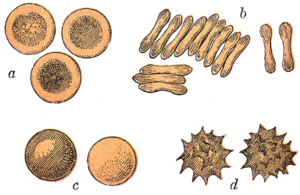
The red blood cells ofmammalsare typically shaped as biconcave disks: flattened and depressed in the center, with a dumbbell-shaped cross section, and atorus-shaped rim on the edge of the disk. This shape allows for a high surface-area-to-volume (SA/V) ratio to facilitate diffusion of gases.[16]However, there are some exceptions concerning shape in theartiodactylorder (even-toedungulatesincluding cattle, deer, and their relatives), which displays a wide variety of bizarre red blood cell morphologies: small and highly ovaloid cells inllamasand camels (familyCamelidae), tiny spherical cells in mouse deer (familyTragulidae), and cells which assume fusiform, lanceolate, crescentic, and irregularly polygonal and other angular forms in red deer and wapiti (familyCervidae). Members of this order have clearly evolved a mode of red blood cell development substantially different from the mammalian norm.[10][17]Overall, mammalian red blood cells are remarkably flexible and deformable so as to squeeze through tinycapillaries,as well as to maximize their apposing surface by assuming a cigar shape, where they efficiently release their oxygen load.[18]
Red blood cells in mammals are unique amongst vertebrates as they do not have nuclei when mature. They do have nuclei during early phases oferythropoiesis,but extrude them during development as they mature; this provides more space for hemoglobin. The red blood cells without nuclei, calledreticulocytes,subsequently lose all other cellularorganellessuch as theirmitochondria,Golgi apparatusandendoplasmic reticulum.
Thespleenacts as a reservoir of red blood cells, but this effect is somewhat limited in humans. In some other mammals such as dogs and horses, the spleen sequesters large numbers of red blood cells, which are dumped into the blood during times of exertion stress, yielding a higher oxygen transport capacity.

Human

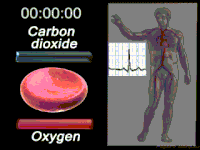
A typical human red blood cell has a disk diameter of approximately6.2–8.2 μm[19]and a thickness at the thickest point of 2–2.5 μm and a minimum thickness in the centre of 0.8–1 μm, being much smaller than most otherhuman cells.These cells have an average volume of about90 fL[20]with a surface area of about 136 μm2,and can swell up to a sphere shape containing 150 fL, without membrane distension.
Adult humans have roughly 20–30 trillion red blood cells at any given time, constituting approximately 70% of all cells by number.[21]Women have about 4–5 million red blood cells per microliter (cubic millimeter) of blood and men about 5–6 million;people living at high altitudeswith low oxygen tension will have more. Red blood cells are thus much more common than the other blood particles: there are about 4,000–11,000white blood cellsand about 150,000–400,000plateletsper microliter.
Human red blood cells take on average 60 seconds to complete one cycle of circulation.[5][9][22]
The blood's red color is due to the spectral properties of thehemicironionsinhemoglobin.Each hemoglobin molecule carries four heme groups; hemoglobin constitutes about a third of the total cell volume. Hemoglobin is responsible for the transport of more than 98% of the oxygen in the body (the remaining oxygen is carried dissolved in theblood plasma). The red blood cells of an average adult human male store collectively about 2.5 grams of iron, representing about 65% of the total iron contained in the body.[23][24]
Microstructure
Nucleus
Red blood cells in mammals areanucleatewhen mature, meaning that they lack acell nucleus.In comparison, the red blood cells of other vertebrates have nuclei; the only known exceptions aresalamandersof the familyPlethodontidae,where five different clades has evolved various degrees of enucleated red blood cells (most evolved in some species of the genusBatrachoseps), and fish of the genusMaurolicus.[25][26][27]
The elimination of the nucleus in vertebrate red blood cells has been offered as an explanation for the subsequentaccumulation of non-coding DNA in the genome.[17]The argument runs as follows: Efficient gas transport requires red blood cells to pass through very narrow capillaries, and this constrains their size. In the absence of nuclear elimination, the accumulation of repeat sequences is constrained by the volume occupied by the nucleus, which increases with genome size.
Nucleated red blood cellsin mammals consist of two forms: normoblasts, which are normal erythropoietic precursors to mature red blood cells, and megaloblasts, which are abnormally large precursors that occur inmegaloblastic anemias.
Membrane composition
Red blood cells are deformable, flexible, are able to adhere to other cells, and are able to interface with immune cells. Theirmembraneplays many roles in this. These functions are highly dependent on the membrane composition. The red blood cell membrane is composed of 3 layers: theglycocalyxon the exterior, which is rich incarbohydrates;thelipid bilayerwhich contains manytransmembrane proteins,besides its lipidic main constituents; and the membrane skeleton, a structural network of proteins located on the inner surface of the lipid bilayer. Half of the membrane mass in human and most mammalian red blood cells are proteins. The other half are lipids, namelyphospholipidsandcholesterol.[28]
Membrane lipids

The red blood cell membrane comprises a typicallipid bilayer,similar to what can be found in virtually all human cells. Simply put, this lipid bilayer is composed ofcholesterolandphospholipidsin equal proportions by weight. The lipid composition is important as it defines many physical properties such as membrane permeability and fluidity. Additionally, the activity of many membrane proteins is regulated by interactions with lipids in the bilayer.
Unlike cholesterol, which is evenly distributed between the inner and outer leaflets, the 5 major phospholipids are asymmetrically disposed, as shown below:
Outer monolayer
- Phosphatidylcholine(PC);
- Sphingomyelin(SM).
Inner monolayer
- Phosphatidylethanolamine(PE);
- Phosphoinositol(PI) (small amounts).
- Phosphatidylserine(PS);
This asymmetric phospholipid distribution among the bilayer is the result of the function of several energy-dependent and energy-independentphospholipidtransport proteins. Proteins called "Flippases"move phospholipids from the outer to the inner monolayer, while others called"floppases"do the opposite operation, against a concentration gradient in an energy-dependent manner. Additionally, there are also"scramblase"proteins that move phospholipids in both directions at the same time, down their concentration gradients in an energy-independent manner. There is still considerable debate ongoing regarding the identity of these membrane maintenance proteins in the red cell membrane.
The maintenance of an asymmetric phospholipid distribution in the bilayer (such as an exclusive localization of PS and PIs in the inner monolayer) is critical for the cell integrity and function due to several reasons:
- Macrophagesrecognize andphagocytosered cells that expose PS at their outer surface. Thus the confinement of PS in the inner monolayer is essential if the cell is to survive its frequent encounters with macrophages of thereticuloendothelial system,especially in thespleen.
- Premature destruction ofthallassemicand sickle red cells has been linked to disruptions of lipid asymmetry leading to exposure of PS on the outer monolayer.
- An exposure of PS can potentiate adhesion of red cells to vascular endothelial cells, effectively preventing normal transit through the microvasculature. Thus it is important that PS is maintained only in the inner leaflet of the bilayer to ensure normal blood flow in microcirculation.
- Both PS andphosphatidylinositol 4,5-bisphosphate(PIP2) can regulate membrane mechanical function, due to their interactions with skeletal proteins such asspectrinandprotein 4.1R.Recent studies have shown that binding of spectrin to PS promotes membrane mechanical stability. PIP2 enhances the binding ofprotein band 4.1Rtoglycophorin Cbut decreases its interaction withprotein band 3,and thereby may modulate the linkage of the bilayer to the membrane skeleton.
The presence of specialized structures named "lipid rafts"in the red blood cell membrane have been described by recent studies. These are structures enriched incholesterolandsphingolipidsassociated with specific membrane proteins, namelyflotillins,STOMatins(band 7),G-proteins,andβ-adrenergic receptors.Lipid raftsthat have been implicated in cell signaling events in nonerythroid cells have been shown in erythroid cells to mediateβ2-adregenic receptorsignaling and increasecAMPlevels, and thus regulating entry ofmalarialparasites into normal red cells.[29][30]
Membrane proteins
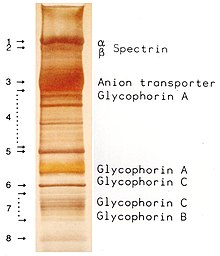
The proteins of the membrane skeleton are responsible for the deformability, flexibility and durability of the red blood cell, enabling it to squeeze through capillaries less than half the diameter of the red blood cell (7–8 μm) and recovering the discoid shape as soon as these cells stop receiving compressive forces, in a similar fashion to an object made of rubber.
There are currently more than 50 known membrane proteins, which can exist in a few hundred up to a million copies per red blood cell. Approximately 25 of these membrane proteins carry the various blood group antigens, such as the A, B and Rh antigens, among many others. These membrane proteins can perform a wide diversity of functions, such as transporting ions and molecules across the red cell membrane, adhesion and interaction with other cells such as endothelial cells, as signaling receptors, as well as other currently unknown functions. Theblood typesof humans are due to variations in surfaceglycoproteinsof red blood cells. Disorders of the proteins in these membranes are associated with many disorders, such ashereditary spherocytosis,hereditary elliptocytosis,hereditary stomatocytosis,andparoxysmal nocturnal hemoglobinuria.[28][29]
The red blood cell membrane proteins organized according to their function:
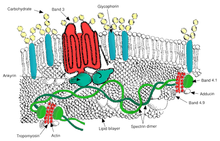
Transport
- Band 3– Anion transporter, also an important structural component of the red blood cell membrane, makes up to 25% of the cell membrane surface, each red cell contains approximately one million copies. Defines theDiego Blood Group;[32]
- Aquaporin 1– water transporter, defines theColton Blood Group;
- Glut1– glucose andL-dehydroascorbic acidtransporter;
- MCT1–Monocarboxylate transporterfor exportingLactic acidto the liver. SeeCori cycle.;[33]
- Kidd antigen protein– urea transporter;
- RHAG– gas transporter, probably of carbon dioxide, defines Rh Blood Group and the associated unusual blood group phenotype Rhnull;
- Na+/K+– ATPase;
- Ca2+– ATPase;
- Na+K+2Cl−– cotransporter;
- Na+-Cl−– cotransporter;
- Na-H exchanger;
- K-Cl – cotransporter;
- Gardos Channel.
Cell adhesion
- ICAM-4– interacts withintegrins;
- BCAM– a glycoprotein that defines theLutheran blood groupand also known asLuorlaminin-binding protein.
Structural role– The following membrane proteins establish linkages with skeletal proteins and may play an important role in regulating cohesion between the lipid bilayer and membrane skeleton, likely enabling the red cell to maintain its favorable membrane surface area by preventing the membrane from collapsing (vesiculating).
- Ankyrin-based macromolecular complex – proteins linking the bilayer to the membrane skeleton through the interaction of their cytoplasmic domains withAnkyrin.
- Band 3– also assembles variousglycolyticenzymes, the presumptive CO2transporter, andcarbonic anhydraseinto a macromolecular complex termed a "metabolon,"which may play a key role in regulating red cell metabolism and ion and gas transportfunction.
- RHAG– also involved in transport, defines associated unusual blood group phenotype Rhmod.
- Protein 4.1R-based macromolecular complex – proteins interacting withProtein 4.1R.
- Protein 4.1R– weak expression ofGerbichantigens;
- Glycophorin Cand D – glycoprotein, definesGerbich Blood Group;
- XK– defines the Kell Blood Group and the Mcleod unusual phenotype (lack of Kx antigen and greatly reduced expression of Kell antigens);
- RhD/RhCE– defines Rh Blood Group and the associated unusual blood group phenotype Rhnull;
- Duffy protein– has been proposed to be associated withchemokineclearance;[34]
- Adducin– interaction with band 3;
- Dematin- interaction with the Glut1 glucose transporter.
Surface electrostatic potential
Thezeta potentialis an electrochemical property of cell surfaces that is determined by the net electrical charge of molecules exposed at the surface of cell membranes of the cell. The normal zeta potential of the red blood cell is −15.7 millivolts(mV).[35]Much of this potential appears to be contributed by the exposedsialic acidresidues in the membrane: their removal results in zeta potential of −6.06 mV.
Function
Role in CO2transport
Recall thatrespiration,as illustrated schematically here with a unit of carbohydrate, produces about as many molecules of carbon dioxide, CO2,as it consumes of oxygen, O2.[36]
Thus, the function of the circulatory system is as much about the transport of carbon dioxide as about the transport of oxygen. As stated elsewhere in this article, most of the carbon dioxide in the blood is in the form of bicarbonate ion. The bicarbonate provides acritical pH buffer.[37]Thus, unlike hemoglobin for O2transport, there is a physiological advantage to not having a specific CO2transporter molecule.
Red blood cells, nevertheless, play a key role in the CO2transport process, for two reasons. First, because, besides hemoglobin, they contain a large number of copies of the enzymecarbonic anhydraseon the inside of their cell membrane.[38]Carbonic anhydrase, as its name suggests, acts as a catalyst of the exchange betweencarbonic acidand carbon dioxide (which is theanhydrideof carbonic acid). Because it is a catalyst, it can affect many CO2molecules, so it performs its essential role without needing as many copies as are needed for O2transport by hemoglobin. In the presence of this catalyst carbon dioxide and carbonic acid reach anequilibriumvery rapidly, while the red cells are still moving through the capillary. Thus it is the RBC that ensures that most of the CO2is transported as bicarbonate.[39][40] At physiological pH the equilibrium strongly favors carbonic acid, which is mostly dissociated into bicarbonate ion.[41]
The H+ ions released by this rapid reaction within RBC, while still in the capillary, act to reduce the oxygen binding affinity of hemoglobin, theBohr effect.
The second major contribution of RBC to carbon dioxide transport is that carbon dioxide directly reacts with globin protein components of hemoglobin to formcarbaminohemoglobincompounds. As oxygen is released in the tissues, more CO2binds to hemoglobin, and as oxygen binds in the lung, it displaces the hemoglobin bound CO2,this is called theHaldane effect.Despite the fact that only a small amount of the CO2in blood is bound to hemoglobin in venous blood, a greater proportion of the change in CO2content between venous and arterial blood comes from the change in this bound CO2.[42]That is, there is always an abundance of bicarbonate in blood, both venous and arterial, because of its aforementioned role as a pH buffer.
In summary, carbon dioxide produced by cellular respiration diffuses very rapidly to areas of lower concentration, specifically into nearby capillaries.[43][44] When it diffuses into a RBC, CO2is rapidly converted by the carbonic anhydrase found on the inside of the RBC membrane into bicarbonate ion. The bicarbonate ions in turn leave the RBC in exchange forchloride ionsfrom the plasma, facilitated by theband 3 anion transport proteincolocated in the RBC membrane. The bicarbonate ion does not diffuse back out of the capillary, but is carried to the lung. In the lung the lowerpartial pressureof carbon dioxide in the alveoli causes carbon dioxide to diffuse rapidly from the capillary into the alveoli. The carbonic anhydrase in the red cells keeps the bicarbonate ion in equilibrium with carbon dioxide. So as carbon dioxide leaves the capillary, and CO2is displaced by O2on hemoglobin, sufficient bicarbonate ion converts rapidly to carbon dioxide to maintain the equilibrium.[38][45][46][47]
Secondary functions
When red blood cells undergoshear stressin constricted vessels, they releaseATP,which causes the vessel walls to relax and dilate so as to promote normal blood flow.[48]
When their hemoglobin molecules are deoxygenated, red blood cells releaseS-Nitrosothiols,which also act to dilate blood vessels,[49]thus directing more blood to areas of the body depleted of oxygen.
Red blood cells can also synthesizenitric oxideenzymatically, usingL-arginineas substrate, as doendothelial cells.[50]Exposure of red blood cells to physiological levels of shear stress activatesnitric oxide synthaseand export of nitric oxide,[51]which may contribute to the regulation of vascular tonus.
Red blood cells can also producehydrogen sulfide,a signalling gas that acts to relax vessel walls. It is believed that the cardioprotective effects of garlic are due to red blood cells converting its sulfur compounds into hydrogen sulfide.[52]
Red blood cells also play a part in the body'simmune response:whenlysedby pathogens such as bacteria, their hemoglobin releasesfree radicals,which break down the pathogen's cell wall and membrane, killing it.[53][54]
Cellular processes
As a result of not containingmitochondria,red blood cells use none of the oxygen they transport; instead they produce the energy carrierATPby theglycolysisofglucoseandlactic acid fermentationon the resultingpyruvate.[55][56]Furthermore, thepentose phosphate pathwayplays an important role in red blood cells; seeglucose-6-phosphate dehydrogenase deficiencyfor more information.
As red blood cells contain no nucleus,protein biosynthesisis currently assumed to be absent in these cells.
Because of the lack of nuclei and organelles, mature red blood cells do not containDNAand cannot synthesize anyRNA(although it does contain RNAs),[57][58]and consequently cannot divide and have limited repair capabilities.[59]The inability to carry outprotein synthesismeans that no virus can evolve to target mammalian red blood cells.[60]However, infection withparvoviruses(such as humanparvovirus B19) can affect erythroid precursors while they still have DNA, as recognized by the presence of giantpronormoblastswith viral particles andinclusion bodies,thus temporarily depleting the blood of reticulocytes and causinganemia.[61]
Life cycle
Human red blood cells are produced through a process namederythropoiesis,developing from committedstem cellsto mature red blood cells in about 7 days. When matured, in a healthy individual these cells live in blood circulation for about 100 to 120 days (and 80 to 90 days in a full terminfant).[62]At the end of their lifespan, they are removed from circulation. In many chronic diseases, the lifespan of the red blood cells is reduced.
Creation
Erythropoiesisis the process by which new red blood cells are produced; it lasts about 7 days. Through this process red blood cells are continuously produced in the redbone marrowof large bones. (In theembryo,theliveris the main site of red blood cell production.) The production can be stimulated by thehormoneerythropoietin(EPO), synthesised by the kidney. Just before and after leaving the bone marrow, the developing cells are known asreticulocytes;these constitute about 1% of circulating red blood cells.
Functional lifetime
The functional lifetime of a red blood cell is about 100–120 days, during which time the red blood cells are continually moved by the blood flow push (inarteries), pull (inveins) and a combination of the two as they squeeze through microvessels such as capillaries. They are also recycled in the bone marrow.[63]
Senescence
The aging red blood cell undergoes changes in itsplasma membrane,making it susceptible to selective recognition bymacrophagesand subsequentphagocytosisin themononuclear phagocyte system(spleen,liverandlymph nodes), thus removing old and defective cells and continually purging the blood. This process is termederyptosis,red blood cell programmed death.[64]This process normally occurs at the same rate of production by erythropoiesis, balancing the total circulating red blood cell count. Eryptosis is increased in a wide variety of diseases includingsepsis,haemolytic uremic syndrome,malaria,sickle cell anemia,beta-thalassemia,glucose-6-phosphate dehydrogenase deficiency,phosphate depletion, iron deficiency andWilson's disease.Eryptosis can be elicited by osmotic shock, oxidative stress, and energy depletion, as well as by a wide variety of endogenous mediators andxenobiotics.Excessive eryptosis is observed in red blood cells lacking the cGMP-dependent protein kinase type I or the AMP-activated protein kinase AMPK.Inhibitorsof eryptosis includeerythropoietin,nitric oxide,catecholaminesand high concentrations ofurea.
Much of the resulting breakdown products are recirculated in the body. The heme constituent of hemoglobin are broken down into iron (Fe3+) andbiliverdin.The biliverdin is reduced tobilirubin,which is released into the plasma and recirculated to the liver bound toalbumin.The iron is released into the plasma to be recirculated by a carrier protein calledtransferrin.Almost all red blood cells are removed in this manner from the circulation before they are old enough tohemolyze.Hemolyzed hemoglobin is bound to a protein in plasma calledhaptoglobin,which is not excreted by the kidney.[65]
Clinical significance
Disease
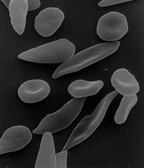
Blood diseasesinvolving the red blood cells include:
- Anemias(or anaemias) are diseases characterized by low oxygen transport capacity of the blood, because of low red cell count or some abnormality of the red blood cells or the hemoglobin.
- Iron deficiency anemiais the most common anemia; it occurs when the dietary intake or absorption of iron is insufficient, and hemoglobin, which contains iron, cannot be formed.
- Pernicious anemiais anautoimmune diseasewherein the body lacksintrinsic factor,required to absorbvitamin B12from food. Vitamin B12is needed for the production of red blood cells and hemoglobin.
- Sickle-cell diseaseis a genetic disease that results in abnormal hemoglobin molecules. When these release their oxygen load in the tissues, they become insoluble, leading to mis-shaped red blood cells. These sickle shaped red cells are less deformable andviscoelastic,meaning that they have become rigid and can cause blood vessel blockage, pain, strokes, and other tissue damage.
- Thalassemiais a genetic disease that results in the production of an abnormal ratio of hemoglobin subunits.
- Hereditary spherocytosissyndromes are a group of inherited disorders characterized by defects in the red blood cell'scell membrane,causing the cells to be small, sphere-shaped, and fragile instead of donut-shaped and flexible. These abnormal red blood cells are destroyed by thespleen.Several other hereditary disorders of the red blood cell membrane are known.[66]
- Aplastic anemiais caused by the inability of thebone marrowto produce blood cells.
- Pure red cell aplasiais caused by the inability of the bone marrow to produce only red blood cells.
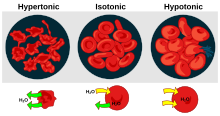
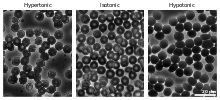
- Hemolysisis the general term for excessive breakdown of red blood cells. It can have several causes and can result inhemolytic anemia.
- Themalariaparasite spends part of its life-cycle in red blood cells, feeds on their hemoglobin and then breaks them apart, causing fever. Bothsickle-cell diseaseandthalassemiaare more common in malaria areas, because these mutations convey some protection against the parasite.
- Polycythemias(or erythrocytoses) are diseases characterized by a surplus of red blood cells. The increased viscosity of the blood can cause a number of symptoms.
- Inpolycythemia verathe increased number of red blood cells results from an abnormality in the bone marrow.
- Severalmicroangiopathic diseases,includingdisseminated intravascular coagulationandthrombotic microangiopathies,present withpathognomonic(diagnostic) red blood cell fragments calledschistocytes.These pathologies generatefibrinstrands that sever red blood cells as they try to move past athrombus.
Transfusion
Red blood cells may be given as part of ablood transfusion.Blood may bedonatedfrom another person, or stored by the recipient at an earlier date. Donated blood usually requiresscreeningto ensure that donors do not contain risk factors for the presence of blood-borne diseases, or will not suffer themselves by giving blood. Blood is usually collected and tested for common or seriousblood-borne diseasesincludingHepatitis B,Hepatitis Cand HIV. Theblood type(A, B, AB, or O) or the blood product is identified and matched with the recipient's blood to minimise the likelihood ofacute hemolytic transfusion reaction,a type oftransfusion reaction.This relates to the presence ofantigenson the cell's surface. After this process, the blood is stored, and within a short duration is used. Blood can be given as a whole product or the red blood cells separated aspacked red blood cells.
Blood is often transfused when there is known anaemia, active bleeding, or when there is an expectation of serious blood loss, such as prior to an operation. Before blood is given, a small sample of the recipient's blood is tested with the transfusion in a process known ascross-matching.
In 2008 it was reported that humanembryonic stem cellshad been successfully coaxed into becoming red blood cells in the lab. The difficult step was to induce the cells to eject their nucleus; this was achieved by growing the cells onstromal cellsfrom the bone marrow. It is hoped that these artificial red blood cells can eventually be used for blood transfusions.[67]
A human trial is conducted in 2022, using blood cultured from stem cells obtained from donor blood.[68]
Tests
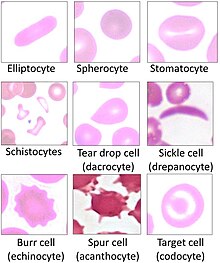
Severalblood testsinvolve red blood cells. These include aRBC count(the number of red blood cells per volume of blood), calculation of thehematocrit(percentage of blood volume occupied by red blood cells), and theerythrocyte sedimentation rate.Theblood typeneeds to be determined to prepare for ablood transfusionor anorgan transplantation.
Many diseases involving red blood cells are diagnosed with ablood film(or peripheral blood smear), where a thin layer of blood is smeared on a microscope slide. This may revealpoikilocytosis,which are variations in red blood cell shape. When red blood cells sometimes occur as a stack, flat side next to flat side. This is known asrouleauxformation,and it occurs more often if the levels of certain serum proteins are elevated, as for instance duringinflammation.
Separation and blood doping
Red blood cells can be obtained fromwhole bloodbycentrifugation,which separates the cells from theblood plasmain a process known asblood fractionation.Packed red blood cells,which are made in this way from whole blood with the plasma removed, are used intransfusion medicine.[69]Duringplasma donation,the red blood cells are pumped back into the body right away and only the plasma is collected.
Some athletes have tried to improve their performance byblood doping:first about 1 litre of their blood is extracted, then the red blood cells are isolated, frozen and stored, to be reinjected shortly before the competition. (Red blood cells can be conserved for 5 weeks at −79 °C or −110 °F, or over 10 years using cryoprotectants[70]) This practice is hard to detect but may endanger the humancardiovascular systemwhich is not equipped to deal with blood of the resulting higherviscosity.Another method of blood doping involves injection witherythropoietinto stimulate production of red blood cells. Both practices are banned by theWorld Anti-Doping Agency.
History
The first person to describe red blood cells was the young Dutch biologistJan Swammerdam,who had used an earlymicroscopein 1658 to study the blood of a frog.[71]Unaware of this work,Anton van Leeuwenhoekprovided another microscopic description in 1674, this time providing a more precise description of red blood cells, even approximating their size, "25,000 times smaller than a fine grain of sand".
In the 1740s,Vincenzo Menghiniin Bologna was able to demonstrate the presence of iron by passing magnets over the powder or ash remaining from heated red blood cells.
In 1901,Karl Landsteinerpublished his discovery of the three mainblood groups—A, B, and C (which he later renamed to O). Landsteiner described the regular patterns in which reactions occurred whenserumwas mixed with red blood cells, thus identifying compatible and conflicting combinations between these blood groups. A year later Alfred von Decastello and Adriano Sturli, two colleagues of Landsteiner, identified a fourth blood group—AB.
In 1959, by use ofX-ray crystallography,Max Perutzwas able to unravel thestructure of hemoglobin,the red blood cell protein that carries oxygen.[72]
The oldest intact red blood cells ever discovered were found inÖtzithe Iceman, a natural mummy of a man who died around 3255 BCE. These cells were discovered in May 2012.[73]
See also
- List of distinct cell types in the adult human body
- Altitude training
- Blood substitute
- Red blood cell indices
- Serum (blood)
- Er blood group collection
References
- ^Kumar V, Abbas AK, Fausto N, Mitchell RN (2007).Robbins Basic Pathology(8th ed.). Saunders.
- ^"Blood Cells".Archived fromthe originalon 23 July 2016.
- ^D'Alessandro A, Dzieciatkowska M, Nemkov T, Hansen KC (March 2017)."Red blood cell proteomics update: is there more to discover?".Blood Transfusion = Trasfusione del Sangue.15(2): 182–187.doi:10.2450/2017.0293-16.PMC5336341.PMID28263177.
- ^Erich Sackmann,Biological Membranes Architecture and Function.,Handbook of Biological Physics, (ed. R.Lipowsky and E.Sackmann, vol.1, Elsevier, 1995
- ^abBlom JA (2003).Monitoring of Respiration and Circulation.CRC Press. p. 27.ISBN978-0-203-50328-7.
- ^Hatton IA, Galbraith ED, Merleau NS, Miettinen TP, Smith BM, Shander JA (September 2023)."The human cell count and size distribution".Proceedings of the National Academy of Sciences of the United States of America.120(39): e2303077120.Bibcode:2023PNAS..12003077H.doi:10.1073/pnas.2303077120.PMC10523466.PMID37722043.
- ^Sender R, Fuchs S, Milo R (August 2016)."Revised Estimates for the Number of Human and Bacteria Cells in the Body".PLOS Biology.14(8): e1002533.doi:10.1371/journal.pbio.1002533.PMC4991899.PMID27541692.
- ^Dean L (2005).Blood Groups and Red Cell Antigens.National Center for Biotechnology Information (US).
- ^abPierigè F, Serafini S, Rossi L, Magnani M (January 2008). "Cell-based drug delivery".Advanced Drug Delivery Reviews.60(2): 286–295.doi:10.1016/j.addr.2007.08.029.PMID17997501.
- ^abGulliver G (1875). "On the size and shape of red corpuscles of the blood of vertebrates, with drawings of them to a uniform scale, and extended and revised tables of measurements".Proceedings of the Zoological Society of London.1875:474–495.
- ^Ruud JT (May 1954). "Vertebrates without erythrocytes and blood pigment".Nature.173(4410): 848–850.Bibcode:1954Natur.173..848R.doi:10.1038/173848a0.PMID13165664.S2CID3261779.
- ^Carroll S(2006).The Making of the Fittest.W.W. Norton.ISBN978-0-393-06163-5.
- ^Maton A, Hopkins J, McLaughlin CW, Johnson S, Warner MQ, LaHart D, Wright JD (1993).Human Biology and Health.Englewood Cliffs, New Jersey: Prentice Hall.ISBN978-0-13-981176-0.
- ^Anthis N (17 April 2008)."Why Are Veins Blue?".Scienceblogs.Retrieved23 April2015.
- ^Snyder GK, Sheafor BA (1999)."Red Blood Cells: Centerpiece in the Evolution of the Vertebrate Circulatory System".Integrative and Comparative Biology.39(2): 189–198.doi:10.1093/icb/39.2.189.
- ^"BBC Bitesize – GCSE Biology – Blood – Revision 2".bbc.co.uk.Retrieved26 November2017.
- ^abGregory TR (2001). "The bigger the C-value, the larger the cell: genome size and red blood cell size in vertebrates".Blood Cells, Molecules & Diseases.27(5): 830–843.CiteSeerX10.1.1.22.9555.doi:10.1006/bcmd.2001.0457.PMID11783946.
- ^Goodman SR, Kurdia A, Ammann L, Kakhniashvili D, Daescu O (December 2007). "The human red blood cell proteome and interactome".Experimental Biology and Medicine.232(11): 1391–1408.doi:10.3181/0706-MR-156.PMID18040063.S2CID32326166.
- ^Turgeon ML (2004).Clinical Hematology: Theory and Procedures.Lippincott Williams & Wilkins. p. 100.ISBN9780781750073.
- ^McLaren CE, Brittenham GM, Hasselblad V (April 1987). "Statistical and graphical evaluation of erythrocyte volume distributions".The American Journal of Physiology.252(4 Pt 2): H857–H866.CiteSeerX10.1.1.1000.348.doi:10.1152/ajpheart.1987.252.4.H857.PMID3565597.
- ^Bianconi E, Piovesan A, Facchin F, Beraudi A, Casadei R, Frabetti F, et al. (1 November 2013)."An estimation of the number of cells in the human body".Annals of Human Biology.40(6): 463–471.doi:10.3109/03014460.2013.807878.hdl:11585/152451.PMID23829164.S2CID16247166.
- ^Hillman RS, Ault KA, Rinder HM (2005).Hematology in Clinical Practice: A Guide to Diagnosis and Management(4th ed.). McGraw-Hill Professional. p. 1.ISBN978-0-07-144035-6.
- ^Iron Metabolism,University of Virginia Pathology. Accessed 22 September 2007.
- ^Bridges KR."Transferrin and Iron Transport Physiology".Information Center for Sickle Cell and Thalassemic Disorders.Retrieved26 March2023.
- ^Cohen WD (1982). "The cytomorphic system of anucleate non-mammalian erythrocytes".Protoplasma.113:23–32.doi:10.1007/BF01283036.S2CID41287948.
- ^Wingstrand KG (1956). "Non-nucleated erythrocytes in a teleostean fish Maurolicus mülleri (Gmelin)".Zeitschrift für Zellforschung und Mikroskopische Anatomie.45(2): 195–200.doi:10.1007/BF00338830.PMID13402080.S2CID12916049.
- ^Mueller, R. L.; Gregory, T. R.; Gregory, S. M.; Hsieh, A.; Boore, J. L. (2008)."Genome size, cell size, and the evolution of enucleated erythrocytes in attenuate salamanders".Zoology.111(3): 218–230.Bibcode:2008Zool..111..218M.doi:10.1016/j.zool.2007.07.010.PMC2435017.PMID18328681.
- ^abcYazdanbakhsh K, Lomas-Francis C, Reid ME (October 2000). "Blood groups and diseases associated with inherited abnormalities of the red blood cell membrane".Transfusion Medicine Reviews.14(4): 364–374.doi:10.1053/tmrv.2000.16232.PMID11055079.
- ^abcMohandas N, Gallagher PG (November 2008)."Red cell membrane: past, present, and future".Blood.112(10): 3939–3948.doi:10.1182/blood-2008-07-161166.PMC2582001.PMID18988878.
- ^Rodi PM, Trucco VM, Gennaro AM (June 2008). "Factors determining detergent resistance of erythrocyte membranes".Biophysical Chemistry.135(1–3): 14–18.doi:10.1016/j.bpc.2008.02.015.hdl:11336/24825.PMID18394774.
- ^Hempelmann E, Götze O (1984). "Characterization of membrane proteins by polychromatic silver staining".Hoppe-Seyler's Z Physiol Chem.365:241–42.
- ^Iolascon A, Perrotta S, Stewart GW (March 2003). "Red blood cell membrane defects".Reviews in Clinical and Experimental Hematology.7(1): 22–56.PMID14692233.
- ^Fisel P, Schaeffeler E, Schwab M (July 2018)."Clinical and Functional Relevance of the Monocarboxylate Transporter Family in Disease Pathophysiology and Drug Therapy".Clinical and Translational Science.11(4): 352–364.doi:10.1111/cts.12551.PMC6039204.PMID29660777.
- ^Denomme GA (July 2004). "The structure and function of the molecules that carry human red blood cell and platelet antigens".Transfusion Medicine Reviews.18(3): 203–231.doi:10.1016/j.tmrv.2004.03.006.PMID15248170.
- ^Tokumasu F, Ostera GR, Amaratunga C, Fairhurst RM (2012) Modifications in erythrocyte membrane zeta potential byPlasmodium falciparuminfection. Exp Parasitol
- ^Guyton AC (1976). "Ch. 41 Transport of Oxygen and Carbon Dioxide in the Blood and Body Fluids".Textbook of Medical Physiology(Fifth ed.). Philadelphia, PA: W. B. Saunders. p. 556.ISBN0-7216-4393-0.
The Respiratory Exchange Ratio is 1:1 when carbohydrate is consumed, it is as low as 0.7 when fat is consumed.
- ^West JB (1974). "Gas Transport to the Periphery".Respiratory Physiology – the essentials.Baltimore, MD: Williams & Wilkens. p. 80.ISBN0-683-08932-3.
Acid Base Status: The transport of CO2 has a profound effect on the acid-base status of blood and the body as a whole. The lung excretes over 10,000 mEq of carbonic acid per day compared to less than 100 mEq of fixed acids by the kidney.
- ^abGuyton AC (1976). "Ch. 41 Transport of Oxygen and Carbon Dioxide in the Blood and Body Fluids".Textbook of Medical Physiology(Fifth ed.). Philadelphia, PA: W. B. Saunders. pp. 553–554.ISBN0-7216-4393-0.
Reaction of Carbon Dioxide with Water in the Red Blood Cells - Effect of Carbonic Anhydrase
- ^Guyton AC (1976). "Ch. 41 Transport of Oxygen and Carbon Dioxide in the Blood and Body Fluids".Textbook of Medical Physiology(Fifth ed.). Philadelphia, PA: W. B. Saunders. pp. 553–554.ISBN0-7216-4393-0.
carbonic anhydrase catalyzes the reaction between carbon dioxide and water.
- ^Comroe Jr JH (1965). "Transport and elimination of carbon dioxide".Physiology of Respiration(1971 ed.). Chicago, IL: Year Book Medical Publishers. p. 176.ISBN0-8151-1824-4.
[carbonic anhdrase] makes the reaction go to the right about 13000 times as fast
- ^Diem K, Lentner C, eds. (1970). "Blood Gasses".Documenta Geigy Scientific Tables(7th ed.). Basle, Switzerland: Ciba-Geigy Limited. pp. 570–571.
In plasma about 5% of CO2 is in physical solution 94% as bicarbonate and 1% as carbamino compounds; in the erythrocytes the corresponding figures are 7%, 82% and 11%.
- ^Guyton AC (1976). "Ch. 41 Transport of Oxygen and Carbon Dioxide in the Blood and Body Fluids".Textbook of Medical Physiology(Fifth ed.). Philadelphia, PA: W. B. Saunders. p. 554.ISBN0-7216-4393-0.
from figure 41-5 Hgb.CO2 is about 23% and bicarbonate is about 70% of the total carbon dioxide transported to the lungs.
- ^Comroe J (1965). "Pulmonary Gas Diffusion".Physiology of Respiration(1971 ed.). Chicago, IL: Year Book Medical Publishers. p. 140.ISBN0-8151-1824-4.
Despite being a heavier molecule, because it is more soluble, the relative rate of diffusion of CO2 is about 20 times the rate of O2
- ^Guyton AC (1976). "Ch. 41 Transport of Oxygen and Carbon Dioxide in the Blood and Body Fluids".Textbook of Medical Physiology(Fifth ed.). Philadelphia, PA: W. B. Saunders. p. 553.ISBN0-7216-4393-0.
carbon dioxide diffuses out of the tissue cells in the gaseous form (but not to a significant effect in the bicarbonate form because the cell membrane is far less permeable to bicarbonate than to the dissolved gas.
- ^Comroe Jr JH (1965). "Transport and elimination of carbon dioxide".Physiology of Respiration(1971 ed.). Chicago, IL: Year Book Medical Publishers. pp. 175–177.ISBN0-8151-1824-4.
the buffering occurred in the red cell
- ^West JB (1974). "Gas Transport to the Periphery".Respiratory Physiology – the essentials.Baltimore, MD: Williams & Wilkens. pp. 77–79.ISBN0-683-08932-3.
CO2Transport
- ^Stone WE (1973). "Ch. 6-1 Uptake and Delivery of the Respiratory Gasses". In Brobeck JR (ed.).Best & Taylor's Physiological basis of medical practice(9th ed.). Baltimore, MD: Williams & Wilkins. pp. 6.16–6.18.ISBN0-683-10160-9.
Transport of CO2as Bicarbonate
- ^Wan J, Ristenpart WD, Stone HA (October 2008)."Dynamics of shear-induced ATP release from red blood cells".Proceedings of the National Academy of Sciences of the United States of America.105(43): 16432–16437.Bibcode:2008PNAS..10516432W.doi:10.1073/pnas.0805779105.PMC2575437.PMID18922780.
- ^Diesen DL, Hess DT, Stamler JS (August 2008)."Hypoxic vasodilation by red blood cells: evidence for an s-nitrosothiol-based signal".Circulation Research.103(5): 545–553.doi:10.1161/CIRCRESAHA.108.176867.PMC2763414.PMID18658051.
- ^Kleinbongard P, Schulz R, Rassaf T, Lauer T, Dejam A, Jax T, et al. (April 2006)."Red blood cells express a functional endothelial nitric oxide synthase".Blood.107(7): 2943–2951.doi:10.1182/blood-2005-10-3992.PMID16368881.S2CID38270024.
- ^Ulker P, Sati L, Celik-Ozenci C, Meiselman HJ, Baskurt OK (2009). "Mechanical stimulation of nitric oxide synthesizing mechanisms in erythrocytes".Biorheology.46(2): 121–132.doi:10.3233/BIR-2009-0532.PMID19458415.
- ^Benavides GA,Squadrito GL,Mills RW, Patel HD, Isbell TS, Patel RP, et al. (November 2007)."Hydrogen sulfide mediates the vasoactivity of garlic".Proceedings of the National Academy of Sciences of the United States of America.104(46): 17977–17982.Bibcode:2007PNAS..10417977B.doi:10.1073/pnas.0705710104.PMC2084282.PMID17951430.
- ^Kesava S (1 September 2007)."Red blood cells do more than just carry oxygen; New findings by NUS team show they aggressively attack bacteria too"(PDF).The Straits Times.Retrieved26 March2013.
- ^Jiang N, Tan NS, Ho B, Ding JL (October 2007). "Respiratory protein-generated reactive oxygen species as an antimicrobial strategy".Nature Immunology.8(10): 1114–1122.doi:10.1038/ni1501.PMID17721536.S2CID11359246.
- ^Berg JM, Tymoczko JL, Stryer L (2012).Biochemistry(7th ed.). New York: W.H. Freeman. pp. 455, 609.ISBN9781429229364.
- ^Tilton WM, Seaman C, Carriero D, Piomelli S (August 1991). "Regulation of glycolysis in the erythrocyte: role of the lactate/pyruvate and NAD/NADH ratios".The Journal of Laboratory and Clinical Medicine.118(2): 146–152.PMID1856577.
- ^Kabanova S, Kleinbongard P, Volkmer J, Andrée B, Kelm M, Jax TW (2009)."Gene expression analysis of human red blood cells".International Journal of Medical Sciences.6(4): 156–159.doi:10.7150/ijms.6.156.PMC2677714.PMID19421340.
- ^Jain V, Yang WH, Wu J, Roback JD, Gregory SG, Chi JT (2022)."Single Cell RNA-Seq Analysis of Human Red Cells".Frontiers in Physiology.13:828700.doi:10.3389/fphys.2022.828700.PMC9065680.PMID35514346.
- ^Alberts, Bruce; Johnson, Alexander; Lewis, Julian; Raff, Martin; Roberts, Keith; Walter, Peter (2002)."Erythropoiesis Depends on the Hormone Erythropoietin".Molecular biology of the cell(4th ed.). New York: Garland.ISBN0-8153-4072-9.Retrieved30 November2023.
- ^Zimmer C (27 March 2007)."Scientists Explore Ways to Lure Viruses to Their Death".The New York Times.Retrieved26 March2013.
- ^Heegaard ED, Brown KE (July 2002)."Human parvovirus B19".Clinical Microbiology Reviews.15(3): 485–505.doi:10.1128/CMR.15.3.485-505.2002.PMC118081.PMID12097253.
- ^Harrison KL (June 1979). "Fetal erythrocyte lifespan".Australian Paediatric Journal.15(2): 96–97.doi:10.1111/j.1440-1754.1979.tb01197.x.PMID485998.S2CID5370064.
- ^Higgins JM (March 2015)."Red blood cell population dynamics".Clinics in Laboratory Medicine.35(1): 43–57.doi:10.1016/j.cll.2014.10.002.PMC4717490.PMID25676371.
- ^Lang F, Lang E, Föller M (October 2012)."Physiology and pathophysiology of eryptosis".Transfusion Medicine and Hemotherapy.39(5): 308–314.doi:10.1159/000342534.PMC3678267.PMID23801921.
- ^Föller M, Huber SM, Lang F (October 2008)."Erythrocyte programmed cell death".IUBMB Life.60(10): 661–668.doi:10.1002/iub.106.PMID18720418.S2CID41603762.
- ^An X, Mohandas N (May 2008). "Disorders of red cell membrane".British Journal of Haematology.141(3): 367–375.doi:10.1111/j.1365-2141.2008.07091.x.PMID18341630.S2CID7313716.
- ^Coghlan A (19 August 2008)."First red blood cells grown in the lab".New Scientist.Retrieved26 March2023.
- ^
"Researchers are trialing lab-grown blood transfusions: What to know".medicalnewstoday.MedicalNewsToday. 11 November 2022.Archivedfrom the original on 15 November 2022.Retrieved17 November2022.
A team of researchers led by the National Health Service (NHS) Blood and Transplant unit recently launched the first clinical trial to transfuse lab-grown red blood cells into a live human.
- ^"Circular of Information for Blood and Blood Products"(PDF).American Association of Blood Banks, American Red Cross, America's Blood Centers. Archived fromthe original(PDF)on 30 October 2011.Retrieved1 November2010.
- ^Valeri CR (8 February 1996)."Frozen Red Cell Technology".In Sparacino L, Manning FJ (eds.).Blood Groups and Red Cell Antigens.National Academies Press (US) – via ncbi.nlm.nih.gov.
- ^"Swammerdam, Jan (1637–1680)", McGraw Hill AccessScience, 2007. Accessed 27 December 2007.
- ^"Max F. Perutz – Biographical".NobelPrize.org.Retrieved23 October2018.
- ^Pappas S (2 May 2012)."'Iceman' mummy holds world's oldest blood cells ".Fox News.Retrieved2 May2012.
External links
- Blood Groups and Red Cell Antigensby Laura Dean. Searchable and downloadable online textbook in the public domain.
- Database of vertebrate erythrocyte sizes.
- Red Gold,PBSsite containing facts and history



